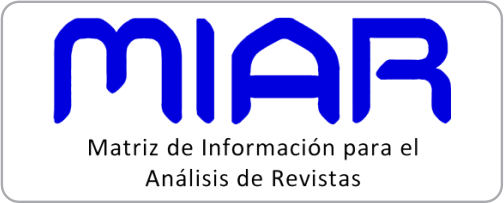La inteligencia de negocios y la analítica de datos en los procesos empresariales
DOI:
https://doi.org/10.51252/rcsi.v1i2.167Palabras clave:
Empírico, empresa, metodología, modelo, sectorResumen
La inteligencia de negocios y la analítica de datos en los procesos empresariales se aplican en varios sectores organizacionales, este último representa un factor de ventaja competitiva, para este fin es necesario utilizar herramientas tecnológicas y definir los procesos que permitan generar modelos maduros de gestión, mientras que la inteligencia de negocios y la analítica de datos representan, como estrategia empresarial, es un factor importante de rendimiento y toma de decisiones. El objetivo fue establecer un marco de referencia teórica de la inteligencia de negocios y la analítica de datos en los procesos empresariales, en este artículo se revisaron artículos de revista indizadas en SCOPUS, Web of Science y Scielo a través del uso de google académico, el rango de revisión fue entre los años 2017 y 2021. Los resultados revelaron que el sector empresarial es donde se aplican con mayor frecuencia las soluciones en inteligencia de negocios y analítica de datos, además la metodología empírica es la más aplicada. Se concluyó que este estudio constituye un marco de referencia teórica para futuras investigaciones sobre la inteligencia de negocios y la analítica de datos en los procesos empresariales.
Citas
Ahmad, S., Miskon, S., Alkanhal, T. A., & Tlili, I. (2020). Modeling of Business Intelligence Systems Using the Potential Determinants and Theories with the Lens of Individual, Technological, Organizational, and Environmental Contexts-A Systematic Literature Review. Applied Sciences, 10(9), 3208. https://doi.org/10.3390/app10093208
Ain, N. U., Vaia, G., DeLone, W. H., & Waheed, M. (2019). Two decades of research on business intelligence system adoption, utilization and success – A systematic literature review. Decision Support Systems, 125(July), 113113. https://doi.org/10.1016/j.dss.2019.113113
Ali, M. S., Khan, S., & Miah, S. J. (2017). Understanding towards Interactions between Business Intelligence and SMEs: Learn from Each Other. Journal of Information Systems and Technology Management, 14(2), 151–168. https://doi.org/10.4301/s1807-17752017000200002
Amankwah-Amoah, J., & Adomako, S. (2019). Big data analytics and business failures in data-Rich environments: An organizing framework. Computers in Industry, 105, 204–212. https://doi.org/10.1016/j.compind.2018.12.015
Arnott, D., Lizama, F., & Song, Y. (2017). Patterns of business intelligence systems use in organizations. Decision Support Systems, 97, 58–68. https://doi.org/10.1016/j.dss.2017.03.005
Balachandran, B. M., & Prasad, S. (2017). Challenges and Benefits of Deploying Big Data Analytics in the Cloud for Business Intelligence. Procedia Computer Science, 112, 1112–1122. https://doi.org/10.1016/j.procs.2017.08.138
Barrera-Narváez, C. F., González-Sanabria, J. S., & Cáceres-Castellanos, G. (2020). Toma de decisiones en el sector turismo mediante el uso de Sistemas de Información Geográfica e inteligencia de negocios. Revista Científica, 38(2), 160–173. https://doi.org/10.14483/23448350.15997
Božič, K., & Dimovski, V. (2019a). Business intelligence and analytics for value creation: The role of absorptive capacity. International Journal of Information Management, 46(February 2018), 93–103. https://doi.org/10.1016/j.ijinfomgt.2018.11.020
Božič, K., & Dimovski, V. (2019b). Business intelligence and analytics use, innovation ambidexterity, and firm performance: A dynamic capabilities perspective. Journal of Strategic Information Systems, 28(4), 101578. https://doi.org/10.1016/j.jsis.2019.101578
Calle Paz, I. I., & Valles Coral, M. A. (2021). Dashboard digital para el monitoreo de indicadores y metas de los proyectos de consultores San Martín E.I.R.L. Revista Científica de Sistemas e Informática, 1(1), 24–36. https://doi.org/10.51252/rcsi.v1i1.94
Cerda-Leiva, L., Araya-Castillo, L., & Barrientos Oradini, N. (2020). ¿Cuánto se ha avanzado en proporcionar analítica e inteligencia de negocios a las pymes? Investigacion & Desarrollo, 19(2), 167–175. https://doi.org/10.23881/idupbo.019.2-11e
Choi, J., Yoon, J., Chung, J., Coh, B. Y., & Lee, J. M. (2020). Social media analytics and business intelligence research: A systematic review. Information Processing and Management, 57(6), 102279. https://doi.org/10.1016/j.ipm.2020.102279
Combita Niño, H. A., Cómbita Niño, J. P., & Morales Ortega, R. (2020). Business intelligence governance framework in a university: Universidad de la costa case study. International Journal of Information Management, 50(October 2018), 405–412. https://doi.org/10.1016/j.ijinfomgt.2018.11.012
Delen, D., & Zolbanin, H. M. (2018). The analytics paradigm in business research. Journal of Business Research, 90(April), 186–195. https://doi.org/10.1016/j.jbusres.2018.05.013
Espinosa Zúñiga, J. J. (2020). Aplicación de metodología CRISP-DM para segmentación geográfica de una base de datos pública. Ingeniería Investigación y Tecnología, 21(1), 1–13. https://doi.org/10.22201/fi.25940732e.2020.21n1.008
Fernando Medina, Q., Francisco Fariña, M., & Castillo-Rojas, W. (2018). Data mart to obtain indicators of academic productivity in a university. Ingeniare, 26, 88–101. https://doi.org/10.4067/S0718-33052018000500088
Fink, L., Yogev, N., & Even, A. (2017). Business intelligence and organizational learning: An empirical investigation of value creation processes. Information and Management, 54(1), 38–56. https://doi.org/10.1016/j.im.2016.03.009
Francia, M., Golfarelli, M., & Rizzi, S. (2020). A-BI+: A framework for Augmented Business Intelligence. Information Systems, 92, 101520. https://doi.org/10.1016/j.is.2020.101520
Gaardboe, R., Nyvang, T., & Sandalgaard, N. (2017). Business Intelligence Success applied to Healthcare Information Systems. Procedia Computer Science, 121, 483–490. https://doi.org/10.1016/j.procs.2017.11.065
Ghashami, A., Alborzi, M., Movahedi Sobhani, F., & Radfar, R. (2019). Un modelo para la implementación de soluciones empresariales inteligentes con base en el nivel de madurez en inteligencia de negocios: una experiencia iraní. AD-Minister, 34, 149–165. https://doi.org/10.17230/ad-minister.34.8
Gonzales, R., & Wareham, J. (2019a). Analysing the impact of a business intelligence system and new conceptualizations of system use. Journal of Economics, Finance and Administrative Science, 24(48), 345–368. https://doi.org/10.1108/JEFAS-05-2018-0052
Gonzales, R., & Wareham, J. (2019b). Analysing the impact of a business intelligence system and new conceptualizations of system use Impact of a business intelligence system 345. Finance and Administrative Science, 24(48), 2077–1886. https://doi.org/10.1108/JEFAS-05-2018-0052
Grytz, R., & Krohn-Grimberghe, A. (2017). Service-Oriented Cost Allocation for Business Intelligence and Analytics. International Journal of Systems and Service-Oriented Engineering, 7(2), 40–57. https://doi.org/10.4018/ijssoe.2017040103
Guitarra Romero, R. (2019). Prospectiva e Inteligencia Estratégica Aplicada a la Micro, Pequeña y Mediana Empresa. Tendencias, 20(1), 107–129. https://doi.org/10.22267/rtend.192001.110
Hindle, G. A., & Vidgen, R. (2018). Developing a business analytics methodology: A case study in the foodbank sector. European Journal of Operational Research, 268(3), 836–851. https://doi.org/10.1016/j.ejor.2017.06.031
Huerta-Riveros, P. C., Gaete-Feres, H. G., & Pedraja-Rejas, L. M. (2020). Strategic management, information system and quality the case of a Chilean public university. In Informacion Tecnologica (Vol. 31, Issue 2, pp. 253–265). Centro de Información Tecnológica. https://doi.org/10.4067/S0718-07642020000200253
Ibrahim, M. S., Hanif, A., Jamal, F. Q., & Ahsan, A. (2019). Towards successful business process improvement – An extension of change acceleration process model. PLOS ONE, 14(11), e0225669. https://doi.org/10.1371/journal.pone.0225669
Jaklič, J., Grublješič, T., & Popovič, A. (2018). The role of compatibility in predicting business intelligence and analytics use intentions. International Journal of Information Management, 43(August), 305–318. https://doi.org/10.1016/j.ijinfomgt.2018.08.017
Khatibi, V., Keramati, A., & Shirazi, F. (2020). Deployment of a business intelligence model to evaluate Iranian national higher education. Social Sciences & Humanities Open, 2(1), 100056. https://doi.org/10.1016/j.ssaho.2020.100056
Kluza, K., & Nalepa, G. J. (2017). A method for generation and design of business processes with business rules. Information and Software Technology, 91, 123–141. https://doi.org/10.1016/j.infsof.2017.07.001
Kumar, A., Luthra, S., Mangla, S. K., & Kazançoğlu, Y. (2020). COVID-19 impact on sustainable production and operations management. Sustainable Operations and Computers, 1, 1–7. https://doi.org/10.1016/j.susoc.2020.06.001
Lea, B. R., Yu, W. Bin, & Min, H. (2018). Data visualization for assessing the biofuel commercialization potential within the business intelligence framework. Journal of Cleaner Production, 188, 921–941. https://doi.org/10.1016/j.jclepro.2018.02.288
Llave, M. R. (2017). Business Intelligence and Analytics in Small and Medium-sized Enterprises: A Systematic Literature Review. Procedia Computer Science, 121, 194–205. https://doi.org/10.1016/j.procs.2017.11.027
Lokaadinugroho, I., Girsang, A. S., & Burhanudin, B. (2021). Tableau Business Intelligence Using the 9 Steps of Kimball’s Data Warehouse & Extract Transform Loading of the Pentaho Data Integration Process Approach in Higher Education. Engineering, MAthematics and Computer Science (EMACS) Journal, 3(1), 1–11. https://doi.org/10.21512/emacsjournal.v3i1.6816
Lopes, J., Guimarães, T., & Santos, M. F. (2020). Adaptive business intelligence: A new architectural approach. Procedia Computer Science, 177, 540–545. https://doi.org/10.1016/j.procs.2020.10.075
Mansell, I. J., & Ruhode, E. (2019). Inhibitors of business intelligence use by managers in public institutions in a developing country: The case of a South African municipality. SA Journal of Information Management, 21(1), 1–8. https://doi.org/10.4102/sajim.v21i1.1004
Margherita, A., & Heikkilä, M. (2021). Business Continuity in the COVID-19 Emergency: A Framework of Actions Undertaken by World-Leading Companies. Business Horizons. https://doi.org/10.1016/j.bushor.2021.02.020
Medina León, A., Nogueira Rivera, D., Hernández-Nariño, A., & Rodríguez, R. C. (2019). Procedure for process management: Methods and support tools. Ingeniare, 27(2), 328–342. https://doi.org/10.4067/S0718-33052019000200328
Mehdouani, K., Missaoui, N., & Ghannouchi, S. A. (2019). An approach for Business Process Improvement Based on Simulation Technique. Procedia Computer Science, 164, 225–232. https://doi.org/10.1016/j.procs.2019.12.176
Meidan, A., García-García, J. A., Escalona, M. J., & Ramos, I. (2017). A survey on business processes management suites. Computer Standards and Interfaces, 51, 71–86. https://doi.org/10.1016/j.csi.2016.06.003
Morales Lugo, H. A., Figueroa Millán, P. E., Farías Mendoza, N., & Chávez Valdez, R. E. (2020). Sistema de inteligencia de negocios para soporte de decisiones en la comercialización de plantas ornamentales. 3C Tecnología. Glosas de innovación aplicadas a la Pyme, 9(3), 17–45. https://doi.org/10.17993/3ctecno/2020.v9n3e35.17-45
Morales, M. F., & Carrión, R. B. (2020). Bibliomining, data, and the decision making process. Revista Interamericana de Bibliotecología, 43(2). https://doi.org/10.17533/UDEA.RIB.V43N2EI8
Moreno, V., Cavazotte, F., & de Souza Carvalho, W. (2020). Business intelligence and analytics as a driver of dynamic and operational capabilities in times of intense macroeconomic turbulence. Journal of High Technology Management Research, 31(2), 100389. https://doi.org/10.1016/j.hitech.2020.100389
Muñoyerro-Muñiz, D., Goicoechea-Salazar, J. A., García-León, F. J., Laguna-Téllez, A., Larrocha-Mata, D., & Cardero-Rivas, M. (2020). Health record linkage: Andalusian health population database. Gaceta Sanitaria, 34(2), 105–113. https://doi.org/10.1016/j.gaceta.2019.03.003
Niño, H. A. C., Niño, J. P. C., & Ortega, R. M. (2020). Business intelligence governance framework in a university: Universidad de la costa case study. International Journal of Information Management, 50(October 2018), 405–412. https://doi.org/10.1016/j.ijinfomgt.2018.11.012
Pappas, I. O., Mikalef, P., Giannakos, M. N., Krogstie, J., & Lekakos, G. (2018). Big data and business analytics ecosystems: paving the way towards digital transformation and sustainable societies. In Information Systems and e-Business Management (Vol. 16, Issue 3, pp. 479–491). Springer Verlag. https://doi.org/10.1007/s10257-018-0377-z
Polyvyanyy, A., Ouyang, C., Barros, A., & van der Aalst, W. M. P. (2017a). Process querying: Enabling business intelligence through query-based process analytics. Decision Support Systems, 100, 41–56. https://doi.org/10.1016/j.dss.2017.04.011
Popovič, A., Puklavec, B., & Oliveira, T. (2019). Justifying business intelligence systems adoption in SMEs: Impact of systems use on firm performance. Industrial Management and Data Systems, 119(1), 210–228. https://doi.org/10.1108/IMDS-02-2018-0085
Porto, R. T., & Sili, M. E. (2020). Decision making and productive management in the agricultural sector of the Northeast of La Pampa (Argentina). Revista de Economia e Sociologia Rural, 58(2). https://doi.org/10.1590/1806-9479.2020.198357
Radenković, M., Lukić, J., Despotović-Zrakić, M., Labus, A., & Bogdanović, Z. (2018). Harnessing business intelligence in smart grids: A case of the electricity market. Computers in Industry, 96, 40–53. https://doi.org/10.1016/j.compind.2018.01.006
Rikhardsson, P., & Yigitbasioglu, O. (2018). Business intelligence & analytics in management accounting research: Status and future focus. International Journal of Accounting Information Systems, 29(April), 37–58. https://doi.org/10.1016/j.accinf.2018.03.001
Sigler, R., Morrison, J., & Moriarity, A. K. (2020). The Importance of Data Analytics and Business Intelligence for Radiologists. Journal of the American College of Radiology, 17(4), 511–514. https://doi.org/10.1016/j.jacr.2019.12.022
Souibgui, M., Atigui, F., Zammali, S., Cherfi, S., & Yahia, S. Ben. (2019). Data quality in ETL process: A preliminary study. Procedia Computer Science, 159, 676–687. https://doi.org/10.1016/j.procs.2019.09.223
Torres, R., Sidorova, A., & Jones, M. C. (2018). Enabling firm performance through business intelligence and analytics: A dynamic capabilities perspective. Information and Management, 55(7), 822–839. https://doi.org/10.1016/j.im.2018.03.010
Trieu, V. H. (2017). Getting value from Business Intelligence systems: A review and research agenda. Decision Support Systems, 93, 111–124. https://doi.org/10.1016/j.dss.2016.09.019
Václav, C., Gabriel, F., Blanka, K., Libor, K., & Michal, T. (2021). Utilization of Business Intelligence Tools in Cargo Control. Transportation Research Procedia, 53, 212–223. https://doi.org/10.1016/j.trpro.2021.02.028
Vajirakachorn, T., & Chongwatpol, J. (2017). Application of business intelligence in the tourism industry: A case study of a local food festival in Thailand. Tourism Management Perspectives, 23, 75–86. https://doi.org/10.1016/j.tmp.2017.05.003
Vallurupalli, V., & Bose, I. (2018). Business intelligence for performance measurement: A case based analysis. Decision Support Systems, 111, 72–85. https://doi.org/10.1016/j.dss.2018.05.002
Vanegas, D. A., Tarazona Bermudez, G. M., & Rodriguez Rojas, L. A. (2020). Mejora de la toma de decisiones en ciclo de ventas del subsistema comercial de servicios en una empresa de IT. Revista Científica, 38(2), 174–183. https://doi.org/10.14483/23448350.15241
Verma, A., Yurov, K. M., Lane, P. L., & Yurova, Y. V. (2019). An investigation of skill requirements for business and data analytics positions: A content analysis of job advertisements. Journal of Education for Business, 94(4), 243–250. https://doi.org/10.1080/08832323.2018.1520685
Zheng, W., Wu, Y. C. J., & Chen, L. (2018). Business intelligence for patient-centeredness: A systematic review. Telematics and Informatics, 35(4), 665–676. https://doi.org/10.1016/j.tele.2017.06.015
Publicado
Cómo citar
Número
Sección
Licencia
Derechos de autor 2021 Edith Barón-Ramírez, Cristian García-Estrella, Silvia Sánchez-Gárate

Esta obra está bajo una licencia internacional Creative Commons Atribución 4.0.
Los autores retienen sus derechos:
a. Los autores retienen sus derechos de marca y patente, y tambien sobre cualquier proceso o procedimiento descrito en el artículo.
b. Los autores retienen el derecho de compartir, copiar, distribuir, ejecutar y comunicar públicamente el articulo publicado en la Revista Científica de Sistemas e Informática (RCSI) (por ejemplo, colocarlo en un repositorio institucional o publicarlo en un libro), con un reconocimiento de su publicación inicial en la RCSI.
c. Los autores retienen el derecho a hacer una posterior publicación de su trabajo, de utilizar el artículo o cualquier parte de aquel (por ejemplo: una compilación de sus trabajos, notas para conferencias, tesis, o para un libro), siempre que indiquen la fuente de publicación (autores del trabajo, revista, volumen, número y fecha).















